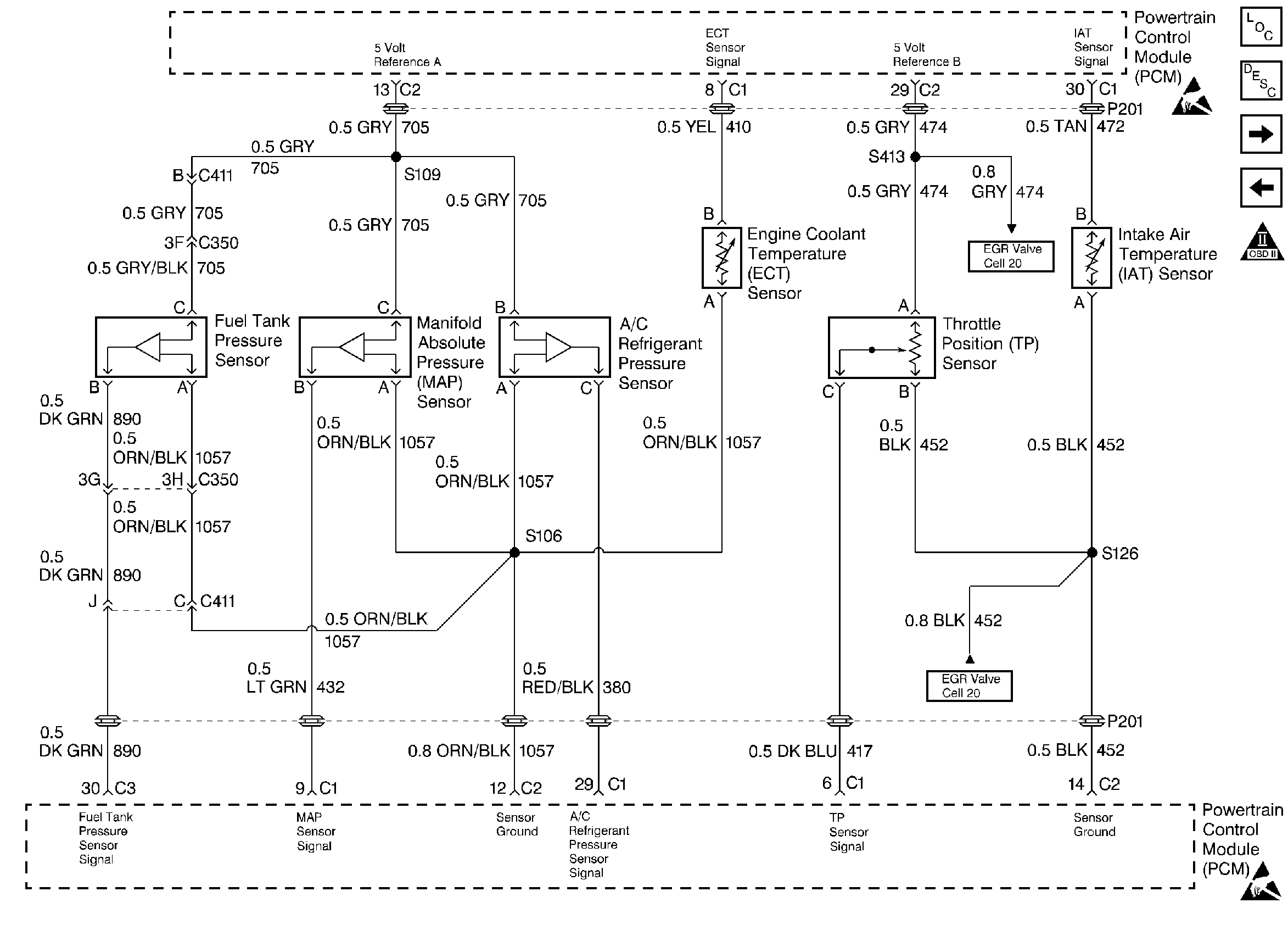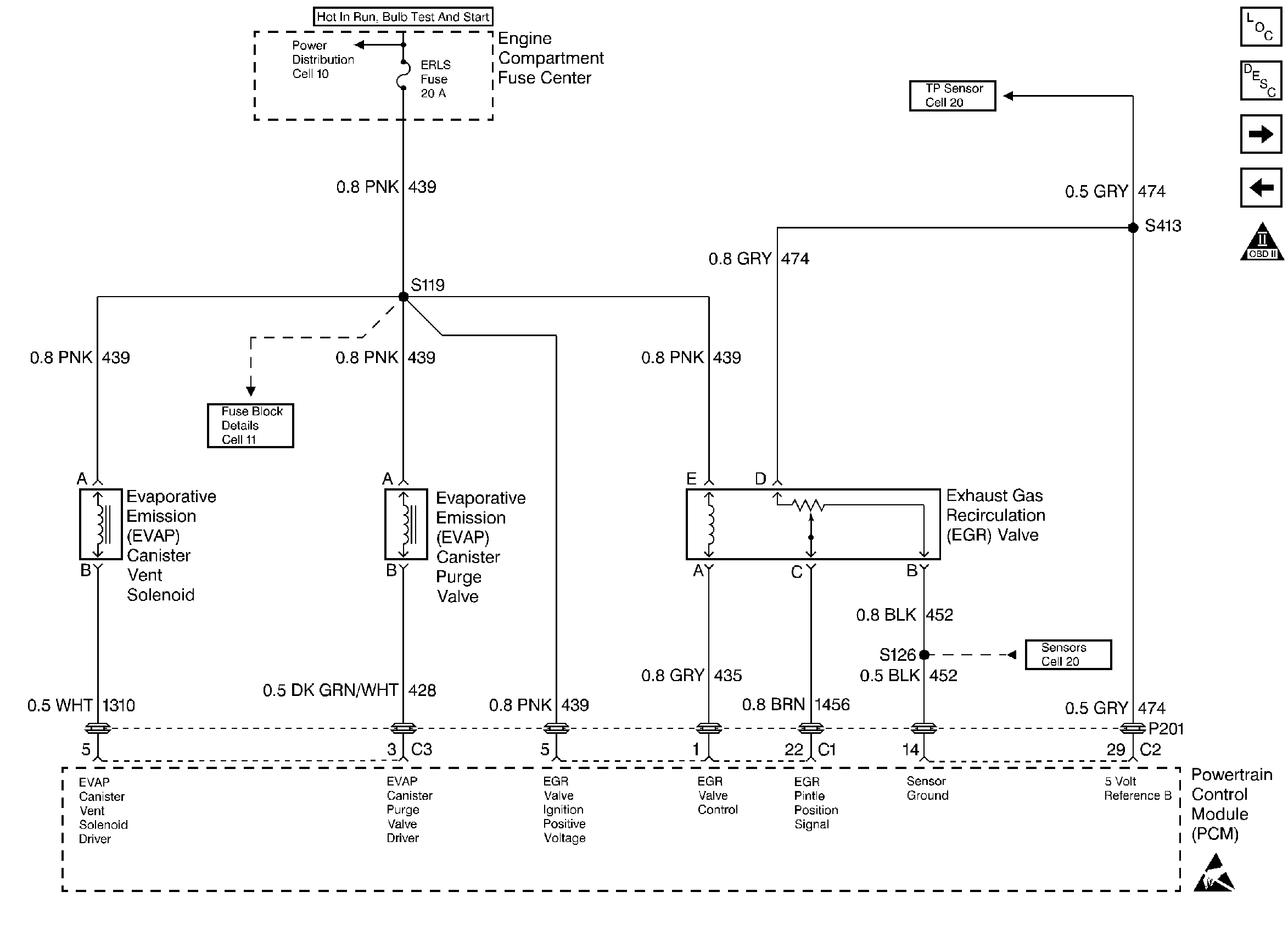Evaporative Emission Control System Diagnosis Fuel Tank Pressure Sensor
Refer to
Engine Data Sensors

and
EVAP and EGR Controls

for wiring view.
Diagnosis
| • | The EVAP system can be diagnosed by using EVAP Control System Diagnosis. |
| • | EVAP canister purge valve operation is covered in this section and diagnosed in DTCs P0440, P0446, and P1441. |
| • | EVAP vent solenoid operation is covered in this section and diagnosed in DTCs P0440, P0442, and P0446. |
| • | Fuel tank vapor pressure sensor operation is covered in this section and diagnosed in DTCs P0440, P0442, P0446, P1441 and Evaporative Emission System Check. |
| • | A open or shorted circuit in the EVAP canister purge valve and EVAP vent solenoid can also be diagnosed in Powertrain Control Module Outputs Diagnosis . |
Visual Check of the EVAP Canister
If cracked or damaged, replace canister. Refer to EVAP Canister Replacement .
Circuit Description
The fuel tank pressure sensor is used to detect vacuum decay and excess vacuum during the EVAP diagnostic routine. The sensor responds to changes in fuel tank pressure or vacuum. The signal voltage to the PCM varies from a minimum of about 0.2 volts with pressure in the fuel tank to above 4 volts with a high vacuum in the fuel tank.
The Fuel Tank Pressure display on the scan tool has an auto zero feature which occurs at each ignition cycle and is corrected according to barometric pressure. Because of this,Fuel Tank Pressure may not accurately reflect the actual output of the sensor or conditions within the fuel tank.
The Fuel Tank Pressure Sensor Diagnosis is intended to isolate and diagnose electrical problems with the sensor wiring or the sensor.
Diagnostic Aids
Check for the following conditions:
| • | Inspect the PCM harness connectors for backed out terminals, improper mating, broken locks, improperly formed or damaged terminals, and for poor terminal to wire connections. |
| • | Inspect the wiring harness for damage. If the harness appears to be OK, observe the Fuel Tank Pressure display on the scan tool while moving connectors and wiring harnesses related to the sensor. A change in the display will indicate the location of the fault. |
Test Description
-
The Powertrain OBD System Check prompts the technician to use the Capture Info . selection on the scan tool. This creates an electronic copy of the freeze frame data taken when the fault occurred. The information is then stored in the scan tool for later reference.
-
Refer to Section 6C for fuel tank removal.
-
A normal fuel tank vapor pressure sensor voltage output with no pressure or vacuum on the fuel system should be between 1.3 V and 1.7 V.
-
Replacement PCMs must be reprogrammed. Refer to the latest Techline information for programming procedures.
Step | Action | Value(s) | Yes | No |
|---|---|---|---|---|
Was the Powertrain On-Board Diagnostic (OBD) System Check performed? | -- | |||
Is voltage near the specified value? | 5V | |||
3 | Check the 5 volt reference A circuit for a poor terminal connection at the PCM. Was a problem found? | -- | ||
4 | Check for an open 5 volt reference A circuit to the fuel tank vapor pressure sensor harness connector. Was a problem found? | -- | ||
Is voltage between the specified values? | 1.3-1.7V | |||
6 | Check the fuel tank vapor pressure sensor signal circuit for a poor terminal connection at the PCM and repair as necessary. Was a repair necessary? | -- | ||
7 | Check the fuel tank pressure signal circuit between the fuel tank vapor pressure sensor connector and the PCM for an open, short to ground, or short to voltage and repair as necessary. Was a repair necessary? | -- | ||
8 | Check the sensor ground circuit for a poor terminal connection at the PCM and repair as necessary. Was a repair necessary? | -- | ||
9 | Check for an open in the sensor ground circuit. Was a problem found? | -- | ||
10 | Check for a poor circuit terminal connection at the fuel tank vapor pressure sensor connector and repair as necessary. Was a repair necessary? | -- | ||
11 | Replace the faulty harness connector terminals as necessary. Is the action complete? | -- | -- | |
12 | Locate and repair open/short circuit in wiring harness as necessary. Is the action complete? | -- | -- | |
13 | Replace the fuel tank vapor pressure sensor. Is the action complete? | -- | -- | |
Replace the PCM. Is the action complete? | -- | -- |
Evaporative Emission Control System Diagnosis LD9
Refer to
Engine Data Sensors

and
EVAP and EGR Controls

for wiring view.
Diagnosis
| • | The EVAP system can be diagnosed by using EVAP Control System Diagnosis. |
| • | EVAP canister purge valve operation is covered in this section and diagnosed in DTCs P0440, P0446, and P1441. |
| • | EVAP vent solenoid operation is covered in this section and diagnosed in DTCs P0440, P0442, and P0446. |
| • | Fuel tank vapor pressure sensor operation is covered in this section and diagnosed in DTCs P0440, P0442, P0446, P1441 and Evaporative Emission System Check. |
| • | A open or shorted circuit in the EVAP canister purge valve and EVAP vent solenoid can also be diagnosed in Powertrain Control Module Outputs Diagnosis . |
Visual Check of the EVAP Canister
If cracked or damaged, replace canister. Refer to EVAP Canister Replacement .
Circuit Description
The evaporative emission system is checked by applying vacuum to the EVAP system and monitoring for a vacuum decay. The PCM monitors the vacuum level through the fuel tank vapor pressure sensor signal. At an appropriate time, the EVAP canister purge valve and the EVAP vent solenoid are turned ON, allowing the engine to draw a small vacuum on the entire evaporative emission system. After the desired vacuum level has been achieved, the EVAP canister purge valve is turned OFF, sealing the system. A leak is detected by monitoring for a decrease in vacuum level over a given time period, when all other variables remain constant. A leak, blockage or faulty component in the system will cause a DTC to be set.
Diagnostic Aids
Check for the following conditions:
| • | Poor electrical connection at PCM. Inspect harness electrical connectors for the following conditions: |
| - | Backed out terminals |
| - | Improper mating |
| - | Broken locks |
| - | Improperly formed |
| - | Damaged terminals |
| - | Poor terminal to wire connection |
| • | Damaged harness--Inspect the wiring harness for damage. If the harness appears to be OK, observe the Fuel Tank Vacuum Pressure display on the scan tool while moving electrical connectors and wiring harnesses related to the sensor. A change in the display will indicate the location of the malfunction. |
| • | Incorrect purge or vacuum source line routing. Verify that the source vacuum and purge lines to the EVAP canister purge solenoid valve are not switched. |
Step | Action | Value(s) | Yes | No |
|---|---|---|---|---|
1 | Was the Powertrain On-Board Diagnostic (OBD) System Check performed? | -- | ||
2 | Are any DTC's set? | -- | Go to DTC Diagnostic Tables first | |
3 |
Is fuel tank pressure at the specified value? | 0 in. H2O (1 in. H2O) | ||
4 |
Important:: Before continuing with diagnosis, zero the EVAP Pressure and Vacuum gages on EVAP pressure/purge cart J 41413 (refer to tool operating instructions).
Is fuel tank pressure at the second specified value? | 5 in. H2O 5 in. H2O (± 2 in. H2O) | ||
5 | Observe EVAP system pressure on the EVAP pressure/purge cart J 41413 while commanding the vent solenoid OFF (Open). Does EVAP system pressure decrease to the specified value within 5 seconds? | 0 in. H2O | Go to DTC P0446 Evaporative Emission (EVAP) Vent System Performance | |
6 |
Is fuel tank pressure decreasing? | 1500 RPM | Go to DTC P1441 Evaporative Emission (EVAP) System Flow During Non-Purge | |
7 |
Is fuel tank pressure decreasing? | 1500 RPM | System OK If a driveability symptom exists, refer to Symptoms |
